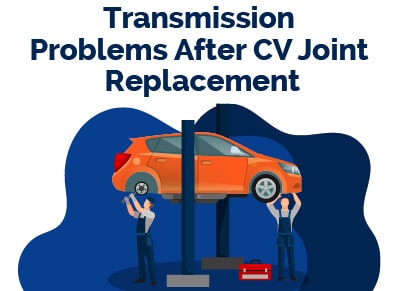Top 5 Transmission Problems After CV Joint Replacement
September 11, 2022


I am a serial entrepreneur and a consumer advocate. When I’m not helping car buyers, I love working on ventures that have a positive impact.
I run a cause marketing agency and serve on the board of Vayu Global Health where we are disrupting the medical industry and preventing the needless deaths of mothers and babies during childbirth.
You need to understand why your transmission developed faults after changing your CV joint to figure out the perfect solution to the problem.
Some reasons you may be experiencing transmission problems after a CV joint replacement are:
- Improper installation
- A lack of lubrication
- Poor installation of an axle
- Faulty seals
- Poor clutch performance
Let’s discuss some of these transmission problems, their causes, and how best to tackle them, so they don’t lead to something more serious.
Table of Contents
Transmission & CV Joint Replacement Video
Common Transmission Problems after CV Joint Replacement
One of the major problems that a transmission develops after changing the CV joint is bad operations and poor transmission performance. The transmission might start slipping. In extreme cases, you should have some excessive vibrations in your drivetrain.
These vibrations usually occur when the CV joints are tightly bonded or your wheel alignment compromises the newly replaced CV joints.
There are still speculations that transmission problems caused by CV joints will trigger a check engine light. However, we haven’t found enough data to support this claim.
What Causes Transmission Problems After CV Joint Replacement?
1. Misalignment and Poor Installation
One of the major reasons why there are transmission problems after CV joint replacement is because they are not properly seated. These issues might not be limited only to the CV joint but also the axle.
If the CV axle is not seated correctly into transmission symptoms, there are chances that you will notice grinding noise after replacement.
The misalignment of your CV joint can lead to many problems in the transmission.
2. Transmission Fluid Leaks
Transmission fluid leaks are some of the reasons why you will experience a transmission problem after a CV joint replacement. These fluid leaks can come from the seals that connect the transmission and the engine or near the drain plug.
Not every driver cares to replace the seals after changing the CV joint or even devoting enough time to inspect them.
In most cases, these transmission fluid leaks are caused by misaligned CV joints. That’s the truth. When the CV joint is not properly seated, it is likely to protrude, hopefully, half an inch on the transmission. This will cause a massive leak in the transmission system.
3. Low Transmission Fluid | Fluid Breakdown
A reduction in your fluid level will lead to transmission problems even after replacing the CV joints. In most cases, low transmission fluid isn’t the major factor, but the fluid breakdown is.
Quality is compromised when the transmission fluid is dirty or broken down. This reduces the amount of lubrication achieved by the system's transmission fluid.
You must understand the duty of the transmission fluid is to lubricate the transmission system and cool down the components.
A good mechanic or repairman must understand the need to top fluid level after changing CV joints. If they forget to do this, the components of your transmission and gears fall the risk of wear and tear.
4. Clogged Transmission Fluid Filter
Sometimes, the problems you are having after replacing your car’s CV joints come from a clogged transmission filter.
Getting the required amount of fluid through the filter becomes challenging if the filter is clogged. This will lead to poor lubrication, which can cause your transmission to start making a grinding noise or overheating.
5. Poor Clutch Performance
If you replaced the CV joint on a bad clutch, there are chances that the transmission will develop problems.
The clutch makes up an integral part of the transmission system. Damage to the clutch will prevent the gears from working properly. This can extend to causing complicated issues with your transmission.
However, few factors determine if a clutch’s poor performance will affect the transmission. A bad clutch will only cause transmission problems if it is not releasing or disengaging. This will spoil the synchros in the transmission system, causing a misalignment of gears.
A slipping clutch can also damage the transmission. This is because of the amount of heat that is generated. This makes it essential that you inspect the clutch after replacing the CV joint.
How To Fix Transmission Problems After Cv Joint Replacement
Did your transmission system develop problems after replacing the CV joint? Here are four ways you can fix it:
1. Thorough Inspection
A thorough inspection is the first thing to do after noticing that your transmission developed problems after replacing the CV joint.
It would be best if you considered taking it to a professional or repair shop to get the transmission tested. They will inspect your car to verify what went wrong and how to fix it.
You can inspect the seals, fluid level, and CV joint position to decide what went wrong.
2. Re-align
After a thorough inspection, the next thing you should do is to realign any parts that don’t sit properly.
Because one of the primary reasons for the transmission problems is misalignment, realigning the CV joint will help solve many problems. Ensure that the CV joints sit into the transmission without any protrusion.
3. Top Transmission Fluid
As you should know, low transmission fluid can cause transmission problems even after changing the CV joints. You’ll have to top the transmission fluid after you’ve verified that it has gone below the fluid level.
4. Fix Any Arising Faults
You might need the services of a trained mechanic to help you diagnose and fix any arising faults in your transmission.
There are chances that your transmission is bad, and we failed to cover its fault. Book a service inspection and let the repairman fix all problems.
Summary
Replacing a bad CV joint is a great way of maintaining your car, but you shouldn’t end there. Most of the arising transmission problems after CV joint replacements are caused by overlooked issues.
After replacing the CV joint, inspect the transmission system and your car’s engine to ensure that you left no stone unturned.
Best Car Deals by Category
Frequently Asked Questions
Can the CV joint cause the transmission to slip?
Yes. A bad Cv joint can cause the transmission to slip. Most times, transmission slips are caused by an internal failure of the transmission, but lack of lubrication can cause slippage. This can extend to affecting the driveshaft, causing a reduction in power transmission.
Can replacing a CV axle damage transmission?
Yes. Replacing a CV axle damages transmission if the axle breaks in the installation process. The replaced CV axle, which is now broken, will no longer transmit the required power from your car’s engine to the wheel. This will cause a loss in power, but in some cases, it will puncture the transmission, thereby damaging it.
Is the CV joint the same as the CV axle?
No. The CV axle is made up of one or more CV joints. The axle is a straight shaft, while the CV joint is just a joint. The CV joint is located in the axle, ensuring the transmission of torque through a certain angle.
Can a CV joint mess up a transmission?
Yes. A CV joint can mess up a transmission more than you can imagine. The damage a CV joint will do to your transmission depends on whether it is broken, bad, or misaligned. In most cases, it can extend to damaging your CV axle, causing more problems to the transmission.
Can you put too much grease in a CV joint?
Putting too much grease on your CV joint is as good as wasting it. You’d only end up making a mess of the CV joint. But if you mean to ask if you can “over grease” a CV joint, then the answer is no.
How much does it cost to replace a CV joint?
The average cost of replacing a CV joint is between $100 - $800. You should factor in the cost of hiring an expert and the cost of materials.
Are CV joints hard to replace?
You can fix your CV joints with little or no professional help. Get a jack, your jack stand, some tools, and work. Your garage is a good place to work it out. You might spend roughly one – three hours fixing the CV joints. This depends on your level of expertise.
Posted in Car Buying Tips, Car Troubleshooting |




